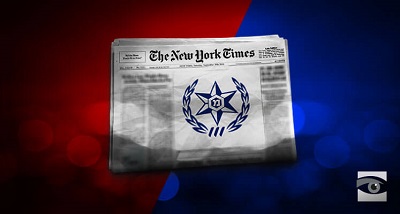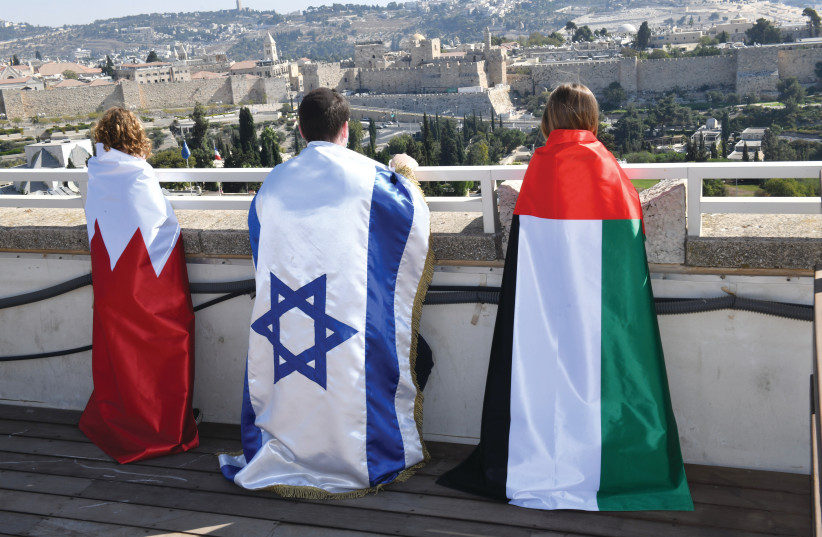
 New York Times wyciąga starą historię, by zmieszać z błotem Izrael
New York Times wyciąga starą historię, by zmieszać z błotem Izrael
Emanuel Miller
Tłumaczenie: Małgorzata Koraszewska
Każdy student dziennikarstwa wie, że przy ocenie, czy sprawa warta jest nagłośnienia, trzeba rozważyć pewne wartości. Czy jest ważna? Czy jest nią zainteresowanie? Czy jest na czasie? I czy jest istotna dla danej publiczności?
To są pytania, z którymi porządni dziennikarze regularnie mają do czynienia. Wydaje się jednak, że w redakcji “New York Times” inne kryteria mają zastosowania przy relacjonowaniu rzekomych występków Izraela.
Niedawny artykuł Davida Halbfingera i Adama Rasgona pokazuje rozmiar głęboko zakorzenionego uprzedzenia wobec Izraela w tej szacownej gazecie. W artykule zatytułowanym “An Autistic Man Is Killed, Exposing Israel’s Festering Police Brutality Problem” [Zabicie mężczyzny z autyzmem obnaża jątrzący się problem brutalności policji w Izraelu] autorzy piszą, że izraelskie władze „nie potrafiły powstrzymać używanie nadmiernej siły, które ma długą historię”.
W całym artykule liczącym ponad 2000 słów autorzy nie wspominają o tym, że Jerozolima jest dręczona przez terroryzm i pozostaje w centrum terytorialnego konfliktu. Izraelscy policjanci i żołnierze, jak również cywile od lata padają ofiarami zamachów z użyciem broni palnej, ataków nożowniczych i taranowania samochodami.
Dopiero w dwunastym akapicie autorzy dają wzmiankę o tej rzeczywistości, a i to w zawoalowany sposób, opisując Stare Miasto Jerozolimy jako “najbardziej wybuchowy punkt zapalny”, gdzie mogą powstawać “śmiercionośne pomyłki”. I dopiero kilka akapitów później wspominają że wszystko to dzieje się na “frontowych liniach narodowego konfliktu”.
Przed podaniem tego kontekstu jednak Halbfinger i Rasgon twierdzą, że “śmiertelna siła, choć rzadka, jest niemal wyłącznie stosowana wobec Arabów i innych mniejszości”. Jest zatem mało prawdopodobne, by czytelnicy pojęli, że Arabowie zabici przez izraelską policję mogli być postrzegani jako wyraźne zagrożenie. Autorzy nie wspominają o dziesięcioleciach szalejącego palestyńskiego terroryzmu, który spowodował, że państwo żydowskie jest w nieustannym stanie najwyższego pogotowia.
Ponadto brutalność policji jest problemem w niemal każdym kraju, a nigdzie bardziej niż w nieliberalnych „demokracjach” i państwach autorytarnych, takich jak Rosja, Iran, Liban, Egipt lub Wenezuela. A jednak z jakiegoś powodu, mimo że ta sprawa nie jest specjalnie istotna dla amerykańskich czytelników i mimo, że działo się to wiele miesięcy temu, „New York Times” obecnie ją wskrzesił.
A są tam jeszcze jak zawsze anonimowi “krytycy”. Tutaj mówią, że „kultura bezkarności przenika siły policyjne [Izraela], szczególnie w wypadkach ofiar z mniejszości. Etiopscy Izraelczycy, ultraortodoksyjni Żydzi i lewicowi aktywiści są nieproporcjonalnie prześladowani”, wraz z Palestyńczykami.
Gdyby “New York Times” naprawdę chciał dostarczyć uczciwej prezentacji tej sytuacji, mógłby pokazać Izrael jako kraj o unikatowych wyzwaniach – kraj, który przyjmował falę za falą imigrantów, zawiera grupy religijnych Żydów, którzy zajadle sprzeciwiają się fundamentom społecznego ładu, na których zbudowane jest nowoczesne państwo Izrael, i istnieje w nim hałaśliwy i konfrontacyjny podział na lewicę i prawicę.
Dobrze udokumentowana obsesja na punkcie Izraela
“New York Times” ma dobrze udokumentowaną chorobliwą obsesję w sprawie śledzenia domniemanych występków Izraela. Na przykład, w 2018 roku zaangażował Forensic Architecture, by pomogła przeprowadzić badanie wypadków z 1 czerwca owego roku, kiedy zginęła 20-letnia pracownica medyczna, Rouzan al-Nadżar , podczas pełnych przemocy rozruchów wzdłuż granicy ze Strefą Gazy.
To wydarzenie wywołało zażartą debatę w owym czasie, a dochodzenie “New York Timesa” ponownie ją później otwarło. Wniosek dochodzenia był jednoznaczny. Izraelski żołnierz strzelił w ziemię, kula odbiła się rykoszetem i zabiła al-Nadżar. Ten wniosek doprowadził do ponowienia oskarżeń, że Izrael popełnił zbrodnię wojenną. Tych właśnie słów użył David Halbfinger w relacji z dochodzenia (podkreślenie dodane) : “Chociaż Izrael później przyznał, że zabicie jej było nieumyślne, wydaje się, że w najlepszym wypadku strzelanie było lekkomyślne, a możliwe, że było zbrodnią wojenną“.
Na końcu liczącego ponad 4700 słów artykułu “New York Times” oświadczył:
Zebraliśmy i przeanalizowaliśmy ponad tysiąc zdjęć i wideo zrobionych 1 czerwca przez fotografów, protestujących, przechodniów i medyków. Przedyskutowaliśmy dowody wizualne z ponad 30 świadkami.
Times na podstawie wideo pola protestu zrobionego z dronu i we współpracy z agencją badawczą Forensic Architecture stworzył trójwymiarowy model tego wydarzenia”.
Warto zatrzymać się tu na chwilę. „New York Times” zbadał ponad tysiąc zdjęć i wideo z tego wydarzenia, ustalił, że pracownica medyczna z Gazy została zabita izraelską kulą, która odbiła się rykoszetem od ziemi i że była to „możliwa zbrodnia wojenna”.
Byłoby to godne śmiechu, gdyby nie było tak skandaliczne i oszczercze.
Warto również zanotować, że ta firma badawcza, Forensic Architecture, przeprowadziła do chwili obecnej 66 badań, z których 14 skupiało się na izraelskich żołnierzach lub na stosunkach między Izraelczykami a Palestyńczykami. Innymi słowy, co piąte przeprowadzone badanie dotyczyło zachowania Izraelczyków.
Nie powinno to stanowić niespodzianki, jako że jest to organizacja kierowana przez Eyala Weizmana, emigranta z Izraela, który prowadził także badania dla B’Tselem o “aspektach planowania izraelskiej okupacji na Zachodnim Brzegu”, który ma ścisłe związki z wieloma radykalnymi, skrajnie lewicowymi organizacjami w Izraelu.
Na przykład, B’Tselem, była oskarżona o “poważne pominięcia i wypaczenia”, używanie danych, które nie są wiarygodne i nie przedstawienie dowodów, które uzasadniałyby oskarżenia tej organizacji, że Izrael złamał międzynarodowe prawo humanitarne podczas wojny 2014 roku z Hamasem w Gazie.
Forensic Architecture prowadziła także “badania” dla Amnesty International, Human Rights Watch, Doctors without Borders (MSF), Red Cross (ICRC) i Organizacji Narodów Zjednoczonych — a wszystkie te organizacje mają co najmniej dziwną historię zachowania wobec Izraela.
Brak odpowiedzialności?
W omawianym wcześniej artykule w wielu miejscach autorzy piszą o braku odpowiedzialności policji, ale ani razu nie zastanawiają się nad naturą izraelskiego społeczeństwa. Podobnie jak wiele innych krajów, Izrael ma swoje podziały i wyzwania, które z czasem prowadzą do dynamiki mogącej prowadzić do zbyt szerokich uprawnień. Jest to znacznie bardziej złożone niż uproszczone stwierdzenie, że izraelscy policjanci lub sam system jest rasistowski.
Kontekst trwającego konfliktu oznacza, że ograniczanie policji i armii nie jest priorytetem w oczach większości Izraelczyków, którzy patrzą na władzę jako na tych, którzy wykonują niezbędną robotę na liniach frontu. Razem z politycznym podziałem na lewicę i prawicę, jaki istnieje we wszystkich demokracjach, oraz podziałami etnicznymi i religijnymi, pełno jest miejsca do analizowania interakcji policji i społeczeństwa. Sami Izraelczycy mają bardzo dużo do powiedzenia na ten temat.
W rzeczywistości izraelska policja nie jest bardziej brutalna niż jej odpowiednicy w innych demokracjach. Izrael jest tyglem różnych etnicznych, politycznych i religijnych grup, a policja ma do czynienia zarówno z cywilnymi sprawami, jak z jednym z najdłużej na świecie trwającym konfliktów. Trzeba uznać tę stresującą sytuację. To nie usprawiedliwia nieakceptowalnego zachowania władz; ale to skupianie się wyłącznie na izraelskim społeczeństwie służy zaognieniu napięć, nie zaś łagodzeniu ich.
Emanuel Miller – Izraelski dziennikarz związany wcześniej z “Jerusalem Post” oraz “Times of Israel”, stworzył dział prasowy My Truth, organizacji zajmującej się dokumentowaniem oraz doświadczeniami izraelskich żołnierzy stawiających czoła, niemoralnemu i cynicznemu wrogowi
Zawartość publikowanych artykułów i materiałów nie reprezentuje poglądów ani opinii Reunion’68,
ani też webmastera Blogu Reunion’68, chyba ze jest to wyraźnie zaznaczone.
Twoje uwagi, linki, własne artykuły lub wiadomości prześlij na adres:
webmaster@reunion68.com




